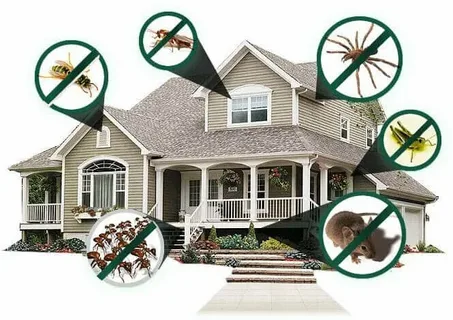Introduction
Nobody wants uninvited critters troubling their home—whether it’s rodents in the attic, ants in the kitchen, or mosquitoes buzzing around the backyard. The good news? Many pest problems can be stopped before they even begin. This guide explores the top pest control methods for homes, blending prevention, natural strategies, and modern techniques for lasting results.

Preventive Measures: Your First Line of Defense
Prevention is foundational—it’s far easier (and cheaper) to keep pests out than to evict them.
Seal Entry Points and Declutter
Pests like mice and cockroaches only need tiny openings to invade your home. Seal gaps around doors, windows, pipes, and foundations using caulk, weather stripping, or steel wool for chew-prone areas. Installing door sweeps and mesh screens adds extra protection. Regularly declutter storage areas and reduce loose debris to eliminate hiding spots.
greenpestmanagementct.comAntiPest Pest Control Services
Maintain Cleanliness and Waste Practices
Crumbs, exposed trash, and uncleaned pet food attract pests. Keep counters, floors, and bins clean, and store pantry staples in airtight containers. Take out the garbage frequently and ensure compost or outdoor bins are well-sealed.
greenpestmanagementct.comRentokil
Address Moisture and Yard Maintenance
Standing water and damp spots lure pests like mosquitoes and termites. Fix leaks, dehumidify basements, and clean gutters. In your yard, trim vegetation, keep firewood away from your home’s perimeter, and minimize debris that can become critter hideouts.
The Sprucegreenpestmanagementct.com
Natural & Eco-Friendly Strategies
Great for minor infestations or prevention—safe for children and pets.
Essential Oils & Repellent Plants
Peppermint, lavender, eucalyptus, and lemon eucalyptus are effective at repelling ants, roaches, and mosquitoes. Citrus peels, like orange, especially when combined with cloves, also deter flies.
Ideal HomeHomes and Gardens
Diatomaceous Earth & Physical Barriers
Food-grade diatomaceous earth (DE) absorbs insect moisture, causing physical elimination. Apply it around baseboards or outside perimeters. Ultraviolet screens, netting, and tight-fitted mesh help block pests from entering.
This Old HouseWikipedia
Biological Control
Harness nature—use ladybugs to control aphids or nematodes for soil pests. This eco-conscious button keeps gardens healthy without chemicals.
pesthandler.comWikipedia
Mechanical and Electronic Tools
Traps & Capture Devices
Set snap traps for rodents, glue boards for crawlers, or bait stations for ants. Beer dishes work for garden slugs. Regular, strategic placement is key.
FieldRoutes
Vacuuming and Suction
A HEPA vacuum picks up visible pests—bed bugs, spiders, larvae—and removes allergens and debris too. Ideal for cracks and tight spaces.
FieldRoutes
Ultrasonic Repellers
These emit inaudible frequencies to deter pests like rodents—chemical-free and low-maintenance. Results can vary, but they offer a non-toxic solution.
Van Den Berge Pest ControlPest Extinct |
Chemical and Advanced Treatments
Used when preventive methods aren’t enough, and often best handled by professionals.
Baits, Traps & Rodenticides
Use strategically placed gel baits or stations—especially for ants and roaches. Owners satisfied with non-toxic options should choose careful, pet-safe products and follow manufacturer instructions.
New York PostBetter Homes & Gardens
Fumigation
For severe infestations like termites or widespread bed bugs, fumigation (tenting your home) offers deep penetration and lasting results—performed only by licensed professionals.
WikipediaPest Extinct |
Heat Treatment
Heat treatments (heating to 120–140°F) are chemical-free and highly effective, especially for pests like bed bugs and fleas.
This Old HouseImperial Pest
Integrated Pest Management (IPM): The Smart Approach
IPM blends all control methods—preventive, natural, mechanical, and chemical—targeted based on pest behavior and population. It’s sustainable, minimizes hazards, and focuses on long-term prevention over quick fixes.
pesthandler.comPest Extinct |Southern Living
DIY Tips vs Professional Help
| Method | Best For |
|---|---|
| Sealing, cleaning, DE | Everyday prevention |
| Natural remedies, traps | Minor or seasonal infestations |
| Baits, heat, fumigation | Moderate to severe infestations |
| IPM | Long-term, eco-aware control |
Experts recommend calling professionals early when infestations worsen or if chemical measures are needed, to avoid bigger issues.
Southern LivingNew York Post
Conclusion
The best home pest control methods combine prevention, cleanliness, natural strategies, and targeted treatments. Whether you’re warding off flying insects with orange peels or trapping rodents, you can protect your home with minimal chemicals and long-term results. If pests persist, don’t hesitate to rely on expert help. Tackle pest control with confidence—and reclaim a safe, serene home.